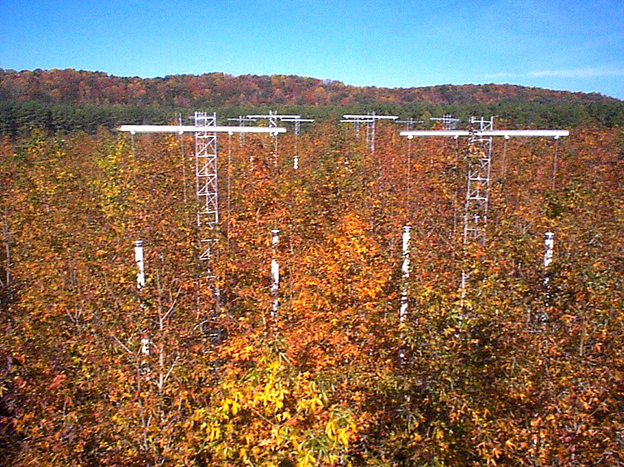March 05, 2021
FACE Experiments Show Autumn Leaf Senescence Will Likely Not Come Earlier in a Future Warm and High-CO2 Climate
Observations of senescence and leaf fall in FACE experiments provide evidence contrary to a published report in Science.

Fall color of sweetgum trees in the ORNL FACE experiment.
[Courtesy Oak Ridge National Laboratory.]
The Science
Zani et al. (Science, 27 November 2020, p. 1066) proposed that enhancement of deciduous tree photosynthesis in a warmer, carbon dioxide (CO2)-enriched atmosphere will lead to earlier autumn senescence. If this premise is true, there would be an important constraint on future growing season length and carbon uptake of trees. This premise, however, is not supported by consistent observations from free-air CO2 enrichment (FACE) experiments. In most FACE experiments leaf senescence or leaf fall was not altered or was delayed in trees exposed to elevated CO2.
The Impact
Autumn phenology was observed in several species of trees for up to 12 years in six FACE experiments. Elevated CO2 usually had no effect or delayed when leaves turned color and fell to the ground. In two experiments, elevated air temperatures and CO2 in outdoor chambers delayed autumn senescence in warmer temperatures, in contrast to the lack of response to warming reported by Zani et al. These FACE and outdoor chamber experiments are realistic tests of CO2 and warming effects on autumn canopy dynamics.
Summary
FACE experiments are controlled experiments of trees exposed in situ for multiple years to future atmospheric CO2 concentrations under real-world environmental conditions. The experiments permitted careful observations of the timing of autumn senescence or leaf fall. Leaf fall of Betula pendula trees occurred later in elevated CO2 compared to control plots in two of four years in the Bangor FACE experiment in Wales and was four to five days later in mature Carpinus betulus and Fagus sylvatica trees in the Web-FACE experiment in Switzerland. The longest record comes from the Oak Ridge National Laboratory (ORNL) FACE experiment with Liquidambar styraciflua trees. The average time of 50% leaf fall over 12 years was day-of-year 283 ± 2.4 in both ambient and elevated CO2. In 9 of 12 years, there was no effect of CO2 on the timing of abscission. There was considerable investment of financial and scientific resources in developing and operating large-scale FACE experiments, and FACE results have supported important advances in ecosystem modeling of CO2 responses and global-scale evaluation of the future trajectory of the terrestrial carbon sink. They provide the best available data for testing hypotheses about ecosystem responses to future atmospheric CO2 conditions, including future projections of autumn phenology.
Principal Investigator
Richard J. Norby
University of Tennessee, Knoxville
rnorby@utk.edu
Program Manager
Daniel Stover
U.S. Department of Energy, Biological and Environmental Research (SC-33)
Environmental System Science
daniel.stover@science.doe.gov
Funding
This research was funded by the Office of Biological and Environmental Research within the U.S. Department of Energy’s Office of Science.
References
Norby, R.J. "Comment on ‘Increased Growing-Season Productivity Drives Earlier Autumn Leaf Senescence in Temperate Trees’." Science 371 (6533), eabg1438 (2021). https://doi.org/10.1126/science.abg1438.

